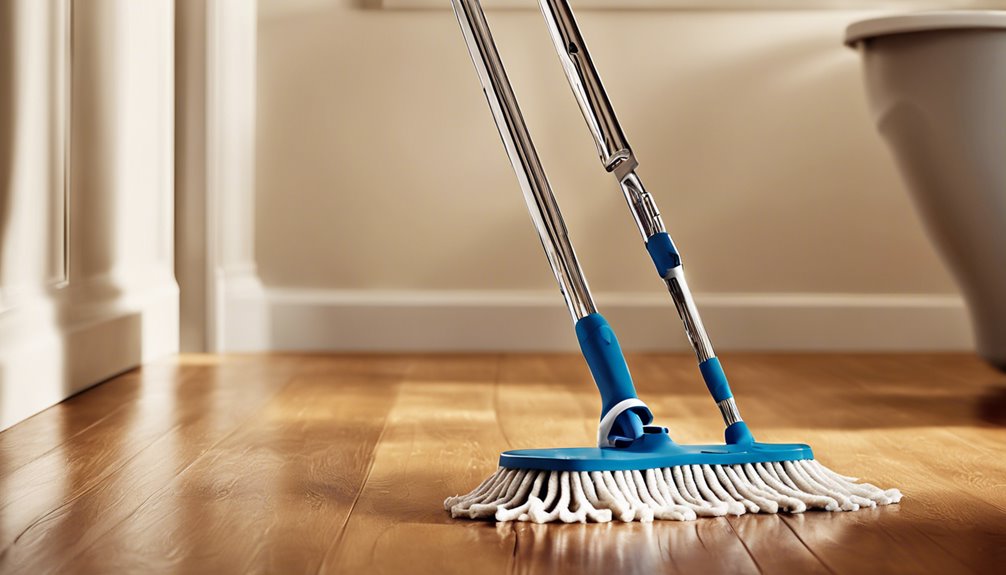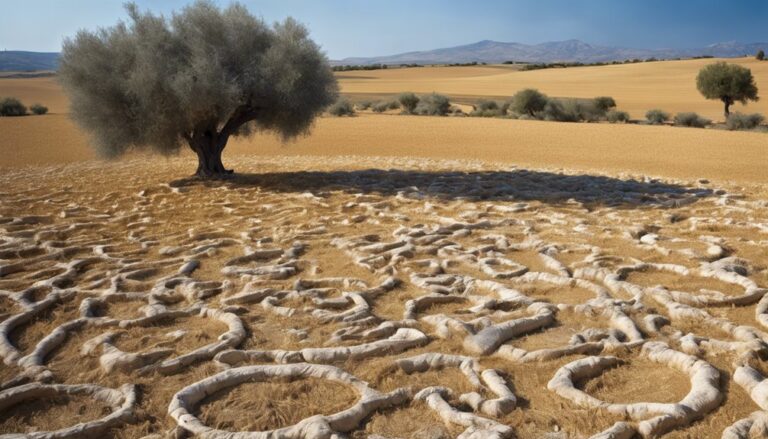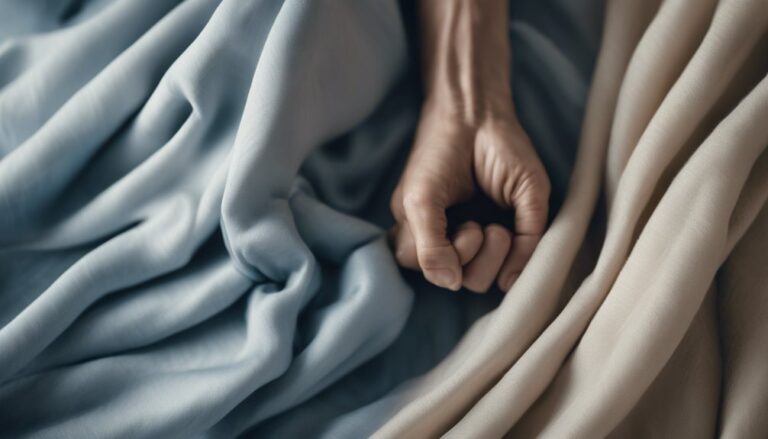Yes, you can mop hardwood floors, but it's crucial to do it correctly to avoid damage. Use a damp microfiber mop with a gentle cleaner specifically designed for wood. Avoid soaking the floor as excess moisture can lead to warping. Regularly sweeping or vacuuming helps maintain cleanliness and prevents scratches. Be cautious about the cleaning products you choose; harsh chemicals can dull the finish. For a more in-depth understanding of caring for your hardwood floors and ensuring their longevity, you might want to explore additional tips and methods.
Understanding Hardwood Floor Care

Caring for hardwood floors requires a blend of knowledge and technique to maintain their beauty and longevity. You'll soon discover the hardwood floor advantages, such as durability and timeless appeal, which can enhance any space. To keep your floors in top condition, establish consistent maintenance routines. Regular sweeping or vacuuming helps prevent dirt buildup that can scratch the surface. When it's time to clean, use a damp mop with a suitable cleaner specifically designed for hardwood. Avoid excessive water, as it can warp the wood. Additionally, applying a protective finish periodically can help preserve the floor's shine and resist wear. By following these steps, you can enjoy your hardwood floors for years to come, maintaining their elegance and enhancing your living environment.
Risks of Mopping Hardwood Floors
While mopping hardwood floors can seem like a straightforward task, it carries several risks that can lead to damage if not approached carefully. Excessive water exposure is one of the biggest concerns, as it can seep into seams, causing warping or buckling over time. Additionally, using the wrong cleaning products can result in dulling the finish or leaving behind residue. You should also consider the cleaning frequency; mopping too often can wear down the protective finish, while infrequent cleaning can lead to dirt buildup, which can scratch the surface. To maintain your hardwood floors, it's essential to balance water use and cleaning intervals, ensuring you keep them looking pristine without compromising their integrity.
Types of Mops for Wood

When it comes to mopping hardwood floors, choosing the right type of mop is vital for maintaining their beauty and integrity. Steam mops are a popular choice, as they use heated steam to sanitize surfaces without excessive water. This method effectively lifts dirt and grime while keeping moisture to a minimum, which is important for wood.
On the other hand, sponge mops offer a gentle cleaning option. They're great for absorbing spills and provide a soft touch that won't scratch the surface. However, make sure you wring them out well to avoid excess water, which can damage your floors. Ultimately, both steam mops and sponge mops can work well, but your choice depends on your cleaning preferences and the condition of your hardwood.
Safe Cleaning Solutions
When it comes to cleaning your hardwood floors, choosing safe cleaning solutions is essential. You'll want to take into account recommended products specifically designed for wood, as well as effective DIY alternatives. It's also vital to avoid harmful chemicals that could damage your floors or pose health risks.
Recommended Cleaning Products
Choosing the right cleaning products for your hardwood floors is essential to maintain their beauty and longevity. Opt for eco-friendly products, as they're safer for both your home and the environment. Many brands offer specially formulated solutions that effectively clean without damaging the wood's finish. If you prefer commercial cleaners, verify they're labeled safe for hardwood use. Always check for pH balance and avoid harsh chemicals like ammonia or bleach, which can strip away the protective coating. Look for products containing natural ingredients that can lift dirt and grime while being gentle on your floors. By selecting the right cleaning solutions, you'll protect your investment and enjoy your hardwood floors' charm for years to come.
DIY Cleaning Solutions
While many commercial cleaners promise to keep your hardwood floors spotless, DIY cleaning solutions can be just as effective and often more economical. Using eco-friendly solutions not only helps the environment but also guarantees your home remains safe for your family. A simple mixture of warm water and a few drops of dish soap can work wonders. If you're looking for a vinegar alternative, try using lemon juice mixed with water. This natural solution cuts through grime and leaves a fresh scent without the harshness of vinegar. Always remember to damp mop rather than soaking your floors. With these DIY approaches, you can maintain the beauty of your hardwood floors while embracing a more sustainable cleaning routine.
Avoiding Harmful Chemicals
To protect both your health and the integrity of your hardwood floors, it's essential to steer clear of harmful chemicals commonly found in many commercial cleaning products. Instead, consider using eco friendly alternatives that effectively clean without compromising your living environment. Vinegar and water make a simple, chemical free option that can help maintain your floors' shine. You can also explore natural oils, such as lemon or tea tree, which not only clean but also add a pleasant scent. Always test any solution on a small area first to verify it won't damage your floors. By opting for these safe cleaning solutions, you can enjoy a clean home while promoting a healthier lifestyle for you and your family.
Alternative Cleaning Methods

When it comes to maintaining your hardwood floors, vacuuming before mopping can greatly enhance the cleaning process by removing loose dirt and debris. Additionally, using microfiber cloths is an effective alternative that traps dust and grime without scratching the surface. These methods not only protect your floors but also guarantee a more thorough clean.
Vacuuming Before Mopping
Before you start mopping your hardwood floors, it's essential to vacuum the surface to remove loose dirt and debris. This step enhances dust removal and guarantees a more effective mopping process. Using proper vacuuming techniques will help maintain your flooring's integrity while making your cleaning easier.
Here are some tips to keep in mind:
- Choose the right vacuum: Opt for a vacuum designed for hardwood to avoid scratches.
- Use attachments: Utilize soft brushes or crevice tools to reach corners and edges effectively.
- Vacuum regularly: Make it a habit to vacuum your floors often to prevent dirt buildup and prolong the life of your hardwood.
Taking these steps will make a noticeable difference in the cleanliness and appearance of your floors.
Using Microfiber Cloths
After vacuuming, using microfiber cloths can greatly enhance your mopping routine for hardwood floors. These cloths offer numerous microfiber benefits, such as superior dust and dirt attraction, thanks to their fine fibers. When you employ effective cleaning techniques with microfiber, you minimize the risk of scratching your floor's surface while achieving a streak-free finish.
Dampening the cloth slightly can aid in lifting stubborn grime without excessive moisture, which is vital for hardwood. Microfiber also dries quickly, reducing the chance of water damage. Plus, they're reusable and machine washable, making them an eco-friendly option. By integrating microfiber cloths into your cleaning arsenal, you can maintain the beauty of your hardwood floors while enjoying the freedom of efficient and effective cleaning.
How to Properly Mop
Though mopping hardwood floors might seem straightforward, doing it properly requires attention to detail to avoid damage. To guarantee your floors stay beautiful, consider these effective mop techniques:
- Use a damp mop: Excess water can warp your hardwood, so keep it lightly damp instead.
- Choose the right cleaner: Use a pH-balanced cleaner designed for hardwood to prevent residue buildup.
- Work in sections: Mop one area at a time, allowing the floor to dry quickly.
Regular cleaning frequency is essential, but remember that the method you choose matters just as much. By following these tips, you'll maintain your hardwood's elegance and extend its lifespan, giving you the freedom to enjoy your space without worry.
Frequency of Cleaning

To keep your hardwood floors looking their best, it's crucial to establish a regular cleaning routine. You should consider daily maintenance tasks to prevent dirt buildup, and don't forget about seasonal deep cleaning for a thorough refresh. Understanding the right frequency for both can help prolong the life of your floors.
Daily Maintenance Recommendations
Cleaning hardwood floors regularly is essential for maintaining their beauty and longevity. Implementing effective daily cleaning and maintenance routines can help you achieve this goal without much hassle. Here are some recommendations to keep your floors looking their best:
- Sweep or vacuum daily: Remove dust and debris that can scratch the surface.
- Damp mop weekly: Use a microfiber mop with a gentle cleaner to avoid excess moisture.
- Use furniture pads: Protect your floors from scratches by placing pads under furniture legs.
Seasonal Deep Cleaning Tips
Regular maintenance is important, but seasonal deep cleaning takes your hardwood floors to the next level. Implementing a thorough clean during spring cleaning and fall maintenance guarantees your floors remain in top condition. Here's a simple guide to help you plan your seasonal cleaning:
| Season | Recommended Actions |
|---|---|
| Spring | Deep clean, polish, check for scratches |
| Summer | Light cleaning, avoid excess moisture |
| Fall | Apply protective coat, remove debris |
Preventing Water Damage
While mopping hardwood floors is essential for maintaining their beauty, it's important to prevent water damage during the process. Excessive water exposure can lead to warping and long-term damage, so practicing moisture control is imperative. Here are some tips to keep in mind:
- Use a damp mop, not soaking wet.
- Quickly dry any spills or excess water.
- Avoid using harsh chemicals that can damage the finish.
Maintaining Floor Shine

To keep your hardwood floors looking their best, it is important to focus on maintaining their shine. Regular floor polishing is vital; it helps remove scratches and enhances the natural luster of the wood. You can use commercially available polish or a homemade solution to maintain a vibrant finish.
For shine restoration, consider applying a specialized hardwood floor cleaner that rejuvenates the coating without leaving residue. Always follow the manufacturer's recommendations for products and methods to avoid damage.
Additionally, keep your floors free of dirt and debris by sweeping or vacuuming regularly. This simple step can prevent dullness and prolong the life of your finish. By prioritizing these maintenance tasks, you'll enjoy beautiful, shiny hardwood floors for years to come.
Professional Cleaning Options
If you're looking for a deeper clean or lack the time to maintain your hardwood floors yourself, considering professional cleaning options can be a wise choice. Professional services can offer specialized cleaning techniques that guarantee your floors look their best while preserving their integrity.
Here are some benefits of hiring experts:
- Expert Knowledge: Professionals understand the specific needs of hardwood and can tailor their approach accordingly.
- Advanced Equipment: They often use high-grade tools and products that aren't available to the average homeowner.
- Time-Saving: You can reclaim your time while experts handle the hard work.
Investing in professional cleaning can enhance the longevity and beauty of your hardwood floors, giving you the freedom to enjoy your space without the hassle.
Frequently Asked Questions
Can Steam Mops Be Used on Hardwood Floors?
When considering steam mops for hardwood floors, it's crucial to weigh steam mop effectiveness against hardwood floor safety. While steam mops can eliminate dirt and germs effectively, the heat and moisture can damage your flooring over time. If you decide to use one, make sure it's specifically designed for hardwood and use it sparingly. Always follow manufacturer guidelines to maintain your floor's integrity while enjoying the convenience of steam cleaning.
How Can I Remove Stains From Hardwood Without Mopping?
Did you know that 80% of hardwood floor stains can be removed with simple home remedies? For effective stain removal, consider cleaning techniques like using a mixture of vinegar and water or baking soda paste. Gently scrub the stained area with a soft cloth, then wipe it clean with a damp cloth. Always test any solution in an inconspicuous spot first to guarantee it won't damage your floor's finish.
Is Vinegar Safe for Cleaning Hardwood Floors?
Vinegar can be a safe option for cleaning hardwood floors, but you've gotta use it carefully. Its benefits include natural disinfecting properties and odor removal. However, vinegar is acidic, which can damage hardwood protection over time if used excessively. It's best to dilute it with water and test a small area first. Always follow up with a dry cloth to prevent moisture damage, ensuring your floors stay beautiful and long-lasting.
What Should I Do if My Hardwood Floor Gets Wet?
If your hardwood floor gets wet, act quickly to prevent water damage. Start by blotting up excess water with a soft cloth or towel. Avoid scrubbing, as that can harm the finish. Make certain the area is well-ventilated, using fans if necessary to aid in drying. For hardwood maintenance, consider applying a wood floor cleaner after it's dry to restore its shine. Always monitor for any signs of warping or discoloration.
Can I Use a Swiffer on Hardwood Floors?
Yes, you can use a Swiffer on hardwood floors, but it's essential to choose the right type of cleaning pad. Opt for ones specifically designed for hardwood to avoid damage. While Swiffers offer convenience, consider Swiffer alternatives like microfiber mops for effective hardwood maintenance. They're gentler and can be used with a damp cloth, ensuring your floors stay pristine without risking scratches. Always remember to follow up with a dry mop for best results.




